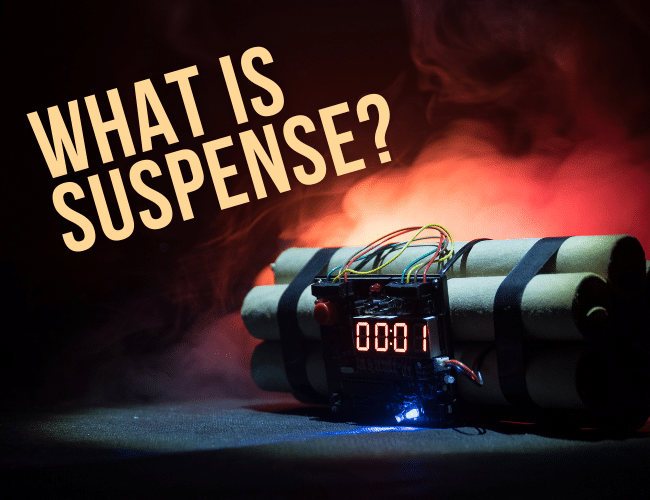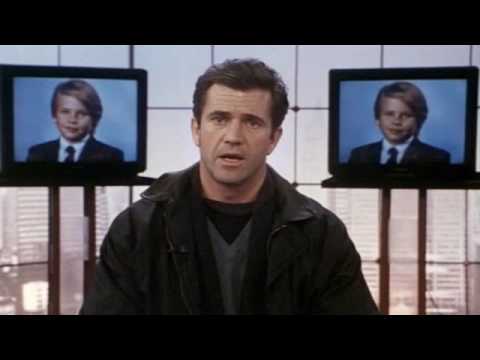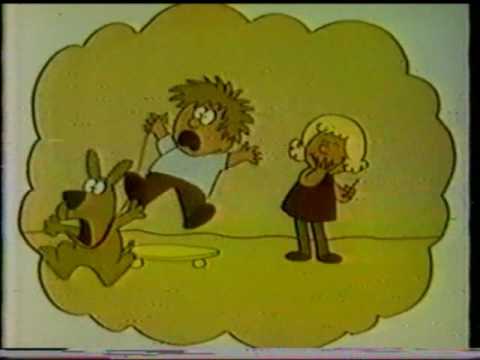Year after year, mysteries, thrillers, and suspense stories dominate at the box office, bookstores, and streaming services. We love suspense. We demand it in our entertainment.
But what (exactly) is suspense in a story? And why does suspense matter so much in a good plot?

Is it possible to examine what constitutes suspense, to understand why readers and viewers find it so enticing? Can you learn how to create and command it to satisfy your own readers?
I think you can.
That’s why I’m writing a special series of articles on the elements of suspense. I believe that by zeroing in on what suspense is and how it works in a story, you can learn to use it in your own writing to enhance the quality of your work.
Suspense teams up with curiosity and surprise to form the dynamo that powers a well-told story. It keeps readers moving forward, engaged and turning pages.
Suspense may be one of the trickiest literary terms to define. In this article, we’ll pin down a working definition of suspense and discuss what distinguishes it from curiosity and surprise.
We’ll also examine reasons why readers find the suspense genres so appealing, and explore some examples of suspense, surprise, and curiosity to see how they function in driving the story forward.
Once you understand what suspense is, you'll see there's no mystery why the suspense genres have become so dramatically popular over the past decades. And also why they show every sign of continuing to attract a large audience.
How I Fell for Suspense
I was born with a love for mystery and suspense. I'm pretty sure it's in my genetic makeup.
Both my parents were big fans, and I grew up listening to Mystery Theater on the radio during family roadtrips and watching late night thrillers on TV like Rear Window and Duel.
I was reading by age four and some of my first favorites were Encyclopedia Brown and Nancy Drew. I grew up in southern Arizona and spent my summers trekking across two miles of hot desert to our local library. I still remember the sweet relief of entering the cool, dim foyer and the smell of old paper and library paste.
I'd sit on the floor in the mystery section, under narrow windows tinted red to dull the searing sun, and build stacks of books to carry home in my backpack. It was hard work, but worth every moment.
And when it comes to my writing, it's always been about suspense. Other kids wanted to grow up to be doctors or firemen. I wanted to write thriller novels.
So I did.
During a recent visit with my sister, she brought up a memory from some of my first writing attempts that had us in stitches. As a writer, you might also find it amusing. Here's a short video account.
All this to say, I love to write stories dripping with suspense in my own books, but I also like teaching writers how to implement suspense in their own stories, especially if they are mysteries, thrillers, or suspense books.
So in this post, we'll talk about the definition of suspense and the whys and hows of using suspense to grip your readers.
We'll also look at examples of suspense along the way!
What is Suspense?
Suspense is the word of the day. This article will dig into the ins and outs, ups and downs of suspense and demonstrate ways you can use it in your own work.
An important distinction exists between suspense as a genre and suspense as an element in a story. While suspense stories, mysteries, and thrillers have plots hinging on—you guessed it—suspense, it's crucial that every story contain suspense in some way.
But what is suspense? We might define the term suspense in a story like this:
When you think about what's at stake and how suspense keeps a reader eager to know the outcome around those stakes, you realize that suspense is a many-splendored thing.
It leads the reader forward through twists and curves, ever beckoning toward a satisfying resolution. It's a bit difficult to hold in your hand and look squarely on the face of it, but this only adds to the mystique and allure of suspense.
That said, we’ll use a working definition of suspense as being the anticipation of an outcome—known or unknown, pleasant or dreaded.
Think about the etymology of the word suspense. It literally ties into something that is hanging, suspended, with an uncertain future. Tension is inherent under such circumstances.
It's interesting to realize that suspense in a story operates on at least two levels:
- What the characters feel as they move closer to an anticipated outcome.
- What the reader experiences, which may be similar.
Or something altogether different.
Now that we've examined what suspense is, let's take a closer look at why it works and what makes suspense an indispensable element in a well-told story.
Why Does Suspense Work in Stories?
It’s human nature to want to see someone with a passion achieve their goal. That desire multiplies when we feel the weight of what’s at stake.
For example, let’s say you’re watching a football game. If you have no affinity for either team, the experience will be rather apathetic.
So, imagine your son is the quarterback for Team A. See how that enhances the suspense? Now it matters.
But let’s raise the stakes.
Let’s say you’re aware that there’s a talent scout for your son’s favorite NFL team in the audience. That bumps the suspense to a higher level, doesn’t it?
And if you want to ratchet the suspense to a fever pitch, let’s say your little girl has been kidnapped, and the captor’s demand is that your son’s team win the game or you’ll never see her again. Now you’re hanging on the edge of your seat, heart pounding, fingernails digging into your palms with every pass and tackle, aren’t you?
For this to happen, the stakes need to be high and the reader needs to be able to clearly identify what the protagonist stands to gain or lose. As conflicts arise—obstacles and complications that keep your character from achieving her goal—the level of suspense increases, keeping the reader glued to the page.
An example of a story with progressive complications that keep ratcheting the suspense to ever-increasing levels is the Mel Gibson movie Ransom. The “simple” kidnap plot goes sideways and with every twist, a happy outcome seems more and more unlikely.
Though your neck may be tight with tension, you'll keep watching to find out if the desperate parents get their boy back unharmed.
It's also very clear when a story is a suspense story because of this tension. Tell me you don't feel that nail-biting grip when you watch this trailer for Ransom, or when you read the back cover for a mystery, thriller, or suspense book.
How Does Suspense Work?
You’re well-versed in story. We all are. We learned it at our mother’s knee and continued the training through every encounter with friends, family, teachers, media—everything.
Every burned finger or bruised ego has a story behind it.
Stories are how we learn in life and what keep us moving forward through the good and the bad.
At its core, the world revolves around story patterns and we all instinctively know how they work—even if we can't talk about the mechanics.
Because of this, we can use the pieces laid out by the storyteller to predict and anticipate what could happen in the story. This is what allows suspense to work as we formulate ideas about what might happen and move eagerly forward to see if we’re right.
Even if the anticipated event doesn’t materialize, we worry and wonder, kept in suspense about whether the story will produce our predicted outcome. And if we guess wrong, we're satisfied by a story that sets up and delivers an ending with a surprising but inevitable twist.
Give your reader all the necessary bits of information and let them fit the pieces together herself, and you've made them an active participant in the story, inherently more invested.
Let's look at an example:
In the movie The Fugitive, the pieces get laid out for us early on. We have Dr. Richard Kimble, wrongfully convicted and imprisoned for killing his wife. We have the one-armed man who committed the crime. We have a US Marshall who cares not one whit about the guilt or innocence of his quarry; he is simply obsessed with capturing Kimble.
We see the pieces moving and predict that Kimble will find the one-armed man and prove his own innocence. This is the outcome we anticipate and we will watch with rapt attention to see how the pieces interact and if we guessed correctly.
Suspense works on the foundational principles of story instinctive to each one of us.
We all want to see what happens in the end, and with a well-constructed story, we hang on with both hands until we see it.
Suspense as a Survival Skill
Suspense depends on your reader’s ability to make predictions based on the clues and information you provide for them. It’s not hard to imagine this as a survival skill, passed down through generations as those best able to interpret the clues lived to tell the tale and contribute to the gene pool.
While those immune to suspense did not.
Okay, so that’s a bit fanciful, but it remains that suspense comes as a result of your reader thinking it through to some extent and anticipating the outcome on some level.
I remember, as a child, watching a sketch on Sesame Street. A cartoon girl wants to pop a balloon with a pin. In her mind’s eye, she sees what might happen: she jabs the pin into the balloon, it pops with a loud bang which startles the cat, which leaps up onto the fireplace mantle, knocking over the vase, which falls to the floor and shatters.
The girl imagines she will end up in big trouble with mom. She anticipates the disaster, and her ability to do this averts it.
There's a another sketch on Sesame Street with this girl imagining what would happen if she pops the balloon and scares her friend Donald. Again, she imagines a play-by-play of what could happen, and then thinks better of it.
In real life, that’s how we want it—disaster averted. In the fiction we consume, it’s the other way around. We demand the disaster and we delight in being able to anticipate it.
That delight we feel is suspense.
And that suspense is what keeps us invested in a story, reading to find out what happens. As you write your own stories, remember to give your characters—and your reader—something to worry about, something to anticipate. Attach high stakes to the outcome, and you've got suspense.
Why Every Story Needs Suspense
Every type of story—not just mysteries and thrillers—must incorporate suspense if it is to sustain a reader’s progress. Suspense is what drives the reader forward, devouring sentence and paragraph to reach the resolution.
For example, the Sophocles play Oedipus Rex relies heavily on suspense as readers (or viewers) press forward to learn how the tragic hero will fulfill the prophecy that predicts he will kill his father and marry his mother.
Shakespeare used suspense in his play Othello to hold the audience in thrall as they watch the title character destroy his life through jealousy, wondering if he’ll find a way to escape the destructive vortex before it’s too late.
Harper Lee’s book To Kill a Mockingbird is filled with suspense as readers wonder about the mysterious neighbor, Boo Radley, and follow the courtroom drama to discover the outcome as Scout’s father defends an accused rapist.
Suspense is what motivates the reader to keep turning pages as they anticipate story events. Every kind of story should have some suspense serving this function, whether slated for a New York editor or simply for your own enjoyment.
But if you’re writing a mystery, thriller, or other type of suspense novel, you’ll need to raise the bar.
For example, in a mystery, you'll need to generate suspicion and provide clues so the reader can solve the crime along with your main character and anticipate the outcome.
In a thriller, you'll need to make sure your reader knows what kind of disaster your protagonist is racing to prevent and the consequences that will rock their world if they fail.
In a suspense story, you need to create an atmosphere of underlying peril and let your reader know things are not what they seem, dropping hints along the way so they can anticipate the truth under the surface.
Never fear! We’ll cover how to do that—and a lot more—in this series of articles, so stay tuned.
Say Hello to Curiosity
The three modalities that entertain a reader and move the story forward are curiosity, surprise, and suspense. While the three are related, they are not synonyms. Let's look at a few differences worth noting.
We make a promise to our readers, right from the first sentences of a story, by way of genre and reader expectations. It’s our job to fulfill that promise. What a reader brings to the table is curiosity and a willingness to be satisfied.
A good story raises questions in the reader’s mind. The big, overarching question won’t get answered until the climactic scene, but intermediate questions carry the story along on a wave of curiosity.
In Writing Mysteries, edited by Sue Grafton, Phyllis A. Whitney said:
“In any piece of writing we can count on reader curiosity to carry the story for a time. Providing, of course, that we furnish something to be curious about . . . Curiosity serves us well in the beginning, and from time to time thereafter.”
Curiosity generates questions, but without the accompanying pieces of information that allow a reader to predict and anticipate, it doesn’t rise to the level of suspense.
For example, story openings often present questions to the reader’s mind, but since the story’s just begun, there’s not much the reader can yet anticipate.
Providing the supporting information, bit by bit, will boost the reader into a state of suspense.
Case in Point: Story Openings
Here are some story openings that perk questions and interest the reader, yet don’t meet the standard of suspense:
I was in a deep sleep, alone aboard my houseboat, alone in the half acre of bed, alone in a sweaty dream of chase, fear, and monstrous predators.
— The Dreadful Lemon Sky, John D. MacDonald
Reading this, we might wonder: Who's in the bed? Why is he alone? Why is he having nightmares? What are the nightmares about?
But without more information, we are not in a position to make many predictions beyond that he will soon wake up with his heart racing. This generates curiosity, but little suspense.
My decision to become a lawyer was irrevocably sealed when I realized my father hated the legal profession.
— The Rainmaker, John Grisham
Reading this, we might wonder: Who is this lawyer? Why does his father hate the legal profession? Why does he hate his father?
Again, we're curious and want to read further to learn answers, but we're not yet driven by suspense.
I suppose he must have been in his early twenties. It was hard to be sure of his age because there was so little of his face available for study.
— The Burglar Who Liked to Quote Kipling, Lawrence Block
The overriding question here is: “What happened to his face?”
This opening creates some compelling curiosity and the beginnings of suspense, but we'll need more information before we can anticipate any meaningful outcome.
Surprise, Surprise!
Some of a story’s most memorable moments strike us out of the blue, coming as a surprise. These surprises pack a punch, keeping us involved with what’s happening on the page and wanting to know more.
In her book Story Genius, Lisa Cron says, “Surprise instantly commands our attention precisely because it defies our expectations.”
That kind of intense focus really is a survival mechanism, causing us to snap to attention and assess the situation to decide what course of action is called for. It can be a life saver.
In story, surprise might come in the opening sentence of a scene or the last, taking the form of a cliffhanger. It's a sudden ripple in our pond, or a big splash.
Either way, surprise is unplanned, unexpected, and hits us with a shock.
Its impact is immediate, but its influence can quickly dissipate, meaning one of the other modalities—curiosity or suspense—will need to take its place to keep us glued to the story.
Let's look at some examples of how surprise is used in story to generate reader response.
3 Examples of Surprise in Stories
Here are three snippets of surprise, bumps in the story road that spring up without warning:
The body had no head. That single, grisly detail was the most prominent feature of the police photographs that were being passed among the three CID officers gathered at the circular table in the Scotland Yard office.
—A Great Deliverance, Elizabeth George
This surprise jumps out at us with that first, stark sentence: The body had no head. It's unexpected. We're reading a murder mystery, so we know there will be a body, but we're unprepared for the fact that the body begins with the stump of a neck.
This provides a quick fizzle of shock, but it sputters out quickly. You can be sure George immediately layered in some suspense to keep her readers engaged.
Steven walked into the utility room, pulled aside the limp beige curtain and gazed past a cut-back crepe myrtle into the side yard. “Nothing. I’m thinking we—”
Emma screamed.
A face studied them through the back window. The man’s head was covered with a stocking, though you could see crew-cut, blondish hair, a colorful tattoo on his neck.
—The Bodies Left Behind, Jeffery Deaver
The scream first gets our surprised attention, and the man's stocking-covered head sustains the surprise a moment longer, but then we're moving into suspense which will take over nicely as the surprise dissipates.
“Hang on!” Steadman shouted, slamming on the brakes and yanking the wheel to the left. The SUV headed straight for the old pickup, headlights bouncing crazily. A split second before impact, the SUV’s wheels slewed right and the whole vehicle dipped backward and sideways, pulling away from the truck.
—Steadman’s Blind, Joslyn Chase
Any time a road accident occurs, it's a surprise. If we knew it was coming, we'd be prepared, but it strikes suddenly and shocks us with unforeseen violence.
In my book, I followed this up immediately with literal suspense, as the SUV hung over the edge of pavement destroyed by volcanic flow. I laid out some possible outcomes for my readers and let them predict what would happen, replacing surprise with suspense.
A Masterful Explanation: When It's Surprise and When It's Suspense
Long acknowledged as the master of suspense, Alfred Hitchcock did a bang-up job of explaining the difference between surprise and suspense. I’ll paraphrase it here:
Let’s say a couple is dining in a restaurant and a bomb suddenly explodes with no warning—that’s surprise. We didn’t see it coming and it shocks or thrills us, giving us fifteen seconds or so of heightened emotion.
But what if we witness the villain’s henchman planting the bomb and setting the timer before the couple arrives? Now, we worry. We wonder through every second of the dinner conversation. Will the bomb go off? Will the couple discover it and escape its blast? Will something else happen to get them out of harm’s way?
That’s suspense.
I think of surprise and suspense like my two favorite flavors of ice cream. Suspense is a deep, dark, intense chocolate. It permeates your senses and triggers your pleasure centers, melting in a slow release of delicious tension.
Surprise, on the other hand, is like the strawberry. It smacks you broadside with a burst both tart and sweet. It’s delectable and satisfying, and then it’s gone. Sometimes leaving behind a sticky mess.
In your own work, you'll want to provide both surprise and suspense for your reader. But use the surprises sparingly, as too many will dilute their effect. Feel free, however, to slather on the suspense.
Why Do Readers Find Suspense So Appealing?
Marie Rodell, in Mystery Fiction, said that people read mysteries to get:
- The vicarious thrill of the manhunt . . . carried on intellectually in the cleverness of detective and reader.
- The satisfaction of seeing the transgressor punished.
- A sense of identification with the people, principally the hero, and events in the story which will make the reader feel more heroic.
- A sense of conviction about the reality of the story.
In Suspense Thriller, Paul Tomlinson points out that the chase and escape scenes provide the same kind of thrill we got as kids from playing a game of tag or hide and seek. And clandestine, secret actions are intrinsically exciting.
When I was in elementary school, my best friend lived around the corner and my biggest thrill came from sneaking down the alley and darting bush to tree in order to reach her house without anyone seeing me. Or so I imagined.
We enjoy that kind of suspense in our fiction partly because it’s cathartic. We are willing to endure through some discomfort because we’ve learned that we can expect certain benefits—a pleasurable rise in heartbeat, an adrenaline rush, maybe even euphoria. We get a workout for the mind, and a reinforcement of values we hold dear, such as life, liberty, and justice.
We can even get a heightened sense of community and a cleansing emotional discharge. All of which also create four unexpected benefits of reading thrillers.
Building the Foundation for Suspense in Your Stories
We’ve seen that suspense is all about anticipation, making your reader look forward to projected events with some kind of emotion—pleasure or dread.
But in order for this to happen, you need to provide the sort of foundation where suspense can begin and build. You need to draw your readers deeply into the story world and make sure they care about what happens to your protagonist.
I’ll teach you how to do this in subsequent articles, sharing specific ways you can build this foundation in your stories, giving you a trusty springboard for suspense.
So don’t forget to bookmark this page, and I’ll see you next time!
How about you? Do you see how curiosity, surprise, and suspense move you forward through the stories you read? Tell us about it in the comments.
PRACTICE
In the last article, The Elements of Suspense, I challenged you to come up with a premise for your own mystery or thriller.
Now, I want you to take that one- or two-sentence idea and expand it by thinking of some future events that might happen in your story. List three or four.
Remember to include a surprise, as well as some slow-burn events around which you can build up a web of suspense.
Take fifteen minutes to make your list of future events. When you are finished, share your work in the comments and be sure to provide feedback for your fellow writers!
Here are some example sentences to illustrate what I mean.
In my story, I might envision a scene revealing a secret relationship between two of my characters (suspense). I might plan something around discovering a character's hidden identity (suspense). And I might throw in a plane crash (surprise!)
Knowing what might happen down the road will help you set it up for your reader.
Notice I said what might happen. Readers aren’t the only ones open to surprise in a book. Sometimes we surprise ourselves with twists we didn’t see at the outset.
Later, we’ll learn how to use foreshadowing to set up events so they feel natural and inevitable without being too predictable. For now, just envision some future events.
Any day where she can send readers to the edge of their seats, prickling with suspense and chewing their fingernails to the nub, is a good day for Joslyn. Pick up her latest thriller, Staccato Passage, an explosive read that will keep you turning pages to the end. No Rest: 14 Tales of Chilling Suspense, Joslyn's collection of short suspense, is available for free at joslynchase.com.




0 Comments